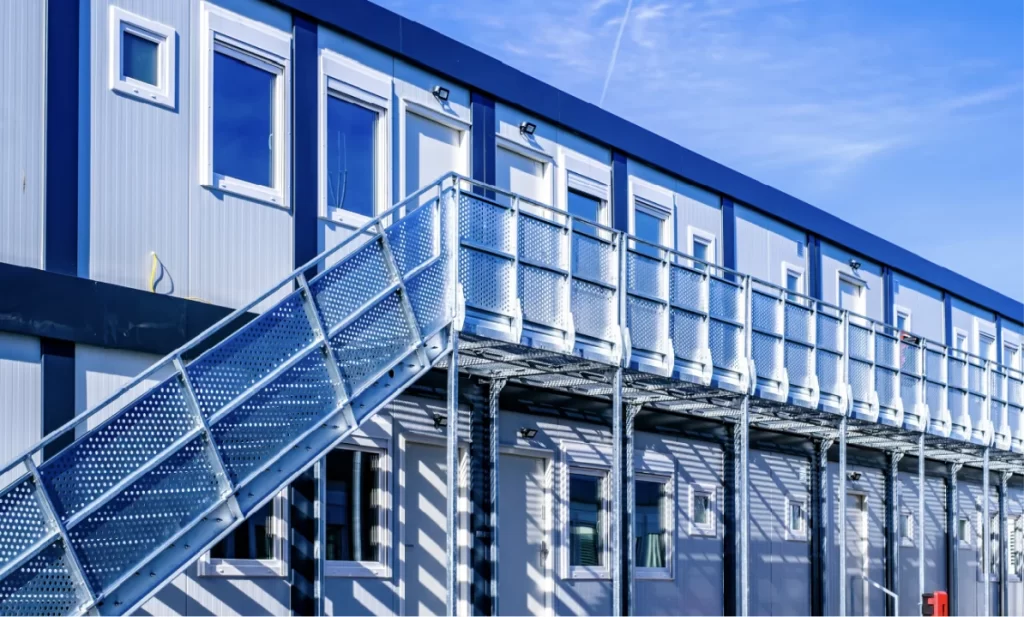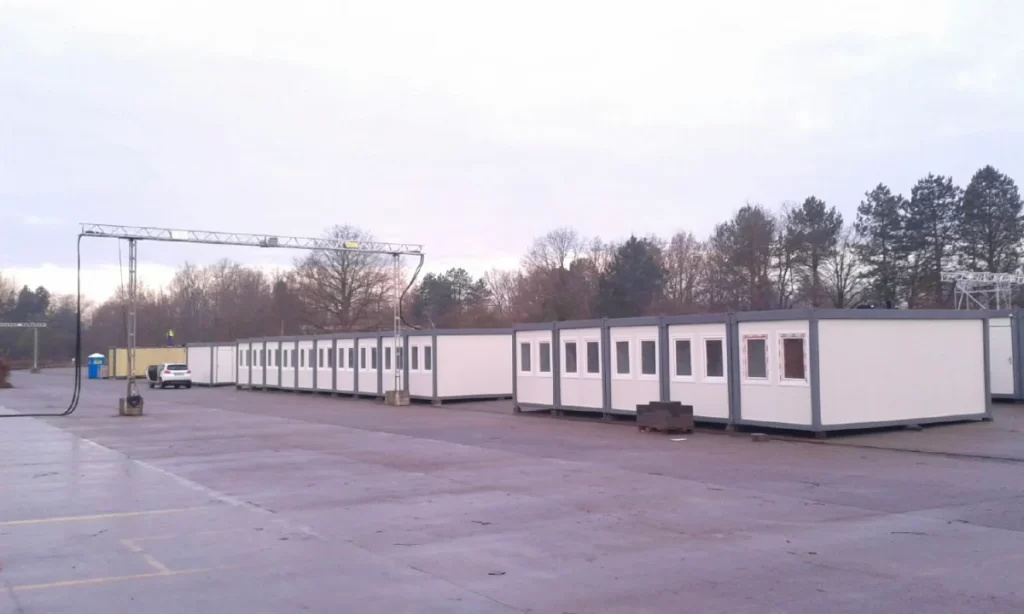MODULAR MILITARY STRUCTURES
Modular military structures are building solutions that can respond to the security and speed requirements of military operations. They stand out as efficient, flexible, and cost-effective building solutions, particularly suited to the rapidly evolving nature of military operations. Traditional military structures involve complex and lengthy construction processes along with high costs. Therefore, they don’t always offer efficiency in meeting needs. Modular military structures have emerged as a solution to such challenges. Made from pre-galvanized material, these structures stand out as durable buildings that show high resistance to weather conditions and other factors, offering significant advantages in terms of speed, sustainability, and flexibility.




What Are Modular Military Structures?
Modular military structures refers to prefabricated structures designed to meet the needs of military operations quickly, safely, and flexibly. Modules designed in a factory environment according to requested specifications and dimensions are quickly assembled at the usage site and made ready. Modules are considered independent units designed to perform a specific function flawlessly. The most important advantage of these structures is that construction times can be completed quickly and practically. The assembled modular structures can serve many different functions such as accommodation, offices, storage areas, health units, dining halls, and command centers.
Modular military structures can be used for short-term military operations as well as being suitable for more permanent military infrastructure. These structures are made flexible by offering customizable and changeable features for all types of military activities.
EMERGENCY SHELTERS

KAHRAMANMARAŞ BAYKAR DISASTER CAMP
After the earthquake on February 6th, a total of 220 container emergency living units were installed in Kahramanmaraş through BAYKAR.

HATAY DISASTER CAMP, TURKEY
Following the earthquake on February 6th, a total of 850 container emergency living units were installed in various regions of Hatay through various aid organizations, chambers of commerce, and representatives of the private sector.

PORTO RICO - EMERGENCY LIVING UNITS
APEC Smart Steel Building Systems were preferred to supply the necessary living units for refugees to be resettled in Porto Rico.
REFUGEE CAMPS

HAMBURG REFUGEE CAMP, GERMANY
A total of 1,100 living units were built for refugees to be resettled in Hamburg, Germany. The project, including dormitories, toilets, showers, and dining areas, was completed and put into use within 60 days according to Eurocode and German DIN standards.

WALLDORF REFUGEE CAMP, GERMANY
A total of 121 living units were built for refugees to be resettled in Walldorf, Germany. The project, including dormitories, toilets, showers, and dining areas, was completed and put into use within 30 days according to Eurocode and German DIN standards.

HOLLAND CAMP
A total of 128 living units were built for refugees to be resettled in Holland. The project, including dormitories, toilets, showers, and dining areas, was completed and put into use within 30 days according to Eurocode and DIN standards.
CONSTRUCION SITE CAMPS

DOHA CAMP BUILDINGS, QATAR
A camp project covering a total area of 15,000 m2, consisting of 760 modules for accommodation, dining halls, offices, health facilities, toilets, and shower units, was built for personnel accommodation in refinery facilities in Qatar.

LATVIA CAMP BUILDINGS -1
A total of 112 specially qualified accommodation units were built for the accommodation needs of military personnel at the Estonian military camp in Latvia.

LATVIA CAMP BUILDINGS -2
A total of 320 specially qualified accommodation units were built for the accommodation needs of military personnel at the Estonian military camp in Latvia.
CONSTRUCTION SITE OFFICES

DOHA DINING HALL AND OFFICE BUILDINGS
A camp project consisting of 87 modules was built for the dining hall and office needs of personnel at refinery facilities in Qatar.

ETİLER CONSTRUCTION SITE OFFICE
The construction of construction site structures, including two and three-story office and dining hall buildings covering a total area of 2,100 m2, is ex-works.

SALES OFFICES GERMANY
Sales office in Gutwerk, GERMANY the structure needed to be used as a APEC Smart Steel Structure Systems in Construction preferred
MODULAR MILITARY BARRACKSS




What Do Modular Military Structures Do? Why Are They Preferred?
There are many reasons why modular military structures are preferred. These structures carry both innovative and cost-effective features compared to traditional structures. Modular structures stand out as rapidly deployable and transportable infrastructure. These structures can be quickly assembled in a war zone, disaster area, or military exercises. The rapid construction of military bases in emergencies is critical for operational success. Modular structures can quickly meet infrastructure needs in these emergencies.
Additionally, modular structures are mobile and can be transported from one region to another. When an area’s military need ends, these structures can be disassembled and relocated to a new area for reassembly. This portability offers a great advantage in adapting to the changing conditions of military operations.
Modular structures can also be designed in different sizes and functions. This allows them to be easily customized according to the needs of military operations. As an operation expands, new modules can be added. Similarly, if needs decrease, modules can be removed. This flexibility allows military infrastructure to adapt quickly.
Modular military structures can be customized to meet a wide variety of military needs. These structures can serve different functions from barracks where soldiers can stay to administrative offices, from medical treatment units to storage areas. Modular structures are diverse enough to be made suitable for any type of military activity.
They can also be suitable for permanent infrastructure, not just temporary use. In war zones or areas with limited access, modular structures can be used for needs such as permanent bases or health units. This increases the effectiveness of modular structures even in long-term operations.
MODULAR HEADQUARTERS/COMMAND CENTER




What Are the Advantages of Modular Military Structures?
The advantages of modular military structures bring significant benefits compared to traditional construction structures. Modular structures can be constructed very quickly thanks to the production of prefabricated modules in the factory. Compared to traditional construction methods, modular structures can be completed within a few weeks. This speed ensures that infrastructure is ready as soon as possible in military operations. Also, since modules are produced in the factory, the impact of weather conditions during the construction process is minimized.
On the other hand, they are generally lower in cost compared to traditional construction methods. This is because the production of modules in the factory reduces labor and material costs. Additionally, modular structures require less material and labor, resulting in significant savings in total construction costs. This is a major advantage for military organizations with limited defense budgets. They can be built to withstand harsh weather conditions, natural disasters, and even military conflicts. Modular structures made using high-quality materials are long-lasting and durable. Thus, it is a critical factor in ensuring the safety of military personnel and ensuring the continuity of operations.
Since military operations will change, modular structures can be easily dismantled and moved to another location. This portability allows military operations to quickly shift to different regions. Additionally, when an area’s infrastructure needs end, these structures can be reused. Modular military structures are also suitable for reuse as they provide durable and long-lasting use.
MODULAR MILITARY WAREHOUSE/LOGISTICS




